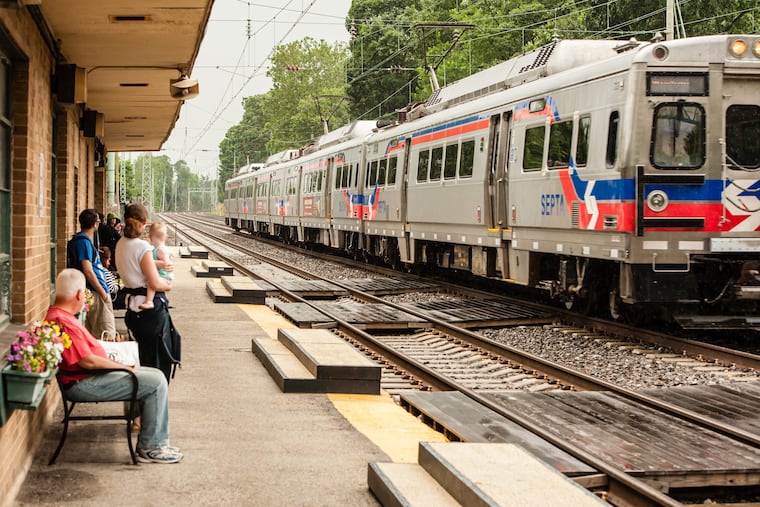How SEPTA got it right on a critical railroad safety system
SEPTA explains how it got Positive Train Control up and running before almost any other railroad in the country.

Railroads across the country are struggling to install the train safety system Positive Train Control in time to meet a congressionally mandated deadline at the end of this year.
One of the few that stands to have the system fully in place by the deadline is SEPTA. The agency has posted some impressive numbers:
100 percent of its locomotives equipped.
100 percent of its employees trained.
100 percent of its track rigged to run with PTC.
PTC systems, which can automatically control the speed or braking of a train to prevent human error and its disastrous consequences, are required by the mandate to be able to control all trains. SEPTA's system is active on all Regional Rail trains but is not yet fully compatible with freight trains that use about 42 miles of Regional Rail track. However, officials say those trains largely run overnight, when commuter trains are idle.
As far back as 2012, when current SEPTA general manager Jeff Knueppel served as deputy general manager, PTC was his top priority. That urgency, he said, was driven by a 2006 crash on the Warminster Line in which two trains collided head-on. No one died, but three crew members and 31 passengers were injured.
>> READ MORE: After Philly crash, railroads got more time to install a key safety system. Three years later, some still lag behind
Prior to PTC, SEPTA had been installing a less sophisticated train control system, Automatic Train Control, and transitioned into PTC using some of the infrastructure already updated for ATC. The work needed was significant. As recently as 2008, some of the switches that allowed a train to shift from one track to another had to be operated by hand.
When an Amtrak train derailed in Philadelphia on May 12, 2015, SEPTA was still installing PTC.
"It definitely strengthened my resolve," Knueppel said of the derailment that killed eight. "I went to a vigil a year later at the site and, yeah, it struck me. It struck me hard."
Several factors allowed SEPTA to get ahead of the curve on PTC, Knueppel said.
SEPTA held together a core management team that kept the PTC installation process focused over a period of years.
"The fact that we were able to hold our team together was huge," Knueppel said.
>>READ MORE: Why SEPTA's safety system didn't stop a train collision at Temple University
During Senate hearings in Washington earlier this year, officials cited management turnover at railroads across the country as a significant obstacle to PTC's timely introduction.
Finding frequencies free from interference to allow communications among trains, track equipment, and dispatch has been a problem in other parts of the country, Knueppel said, but SEPTA was able to secure four channels from a private individual for $480,000, a good price, he said.
SEPTA chose to install PTC through what's called a design-build model, in which a contractor — in SEPTA's case, Hitachi Rail — both designs the installation and does the construction itself, Knueppel said. Going that route sped up the process and allowed it to progress more quickly. It ultimately cost SEPTA about $344 million to get the system operational on 280 miles of track.
SEPTA's major unfinished business with PTC installation is making its system compatible with the other railroads that share track with it, including Amtrak and freight carriers CSX and Norfolk Southern. That is less of a problem than it might have been, due to some decisions SEPTA made early in the process of installing PTC.
SEPTA uses ACSES, a form of PTC also used by Amtrak, so it is much easier for the railroads to operate in sync. But it also addressed the problem of interoperability between railroads by separating itself from another railroad entirely. The West Trenton Line shared track with CSX, but from 2013 to 2015 SEPTA spent $32 million to add a separate six-mile track for its own trains to run on, eliminating the need to integrate CSX into its system on that busy route.
>>READ MORE: Amtrak's challenge: Fix safety lapses that caused fatal 2016 crash in Chester
SEPTA still has holes in its PTC in three locations, though, where it shares interlockings with Amtrak. PTC is partially operational but cannot register temporary speed restrictions. The railroads compensate by coordinating, but SEPTA is waiting on Amtrak to activate PTC in the area.
PTC also isn't fully integrated with freight trains on 42 miles of track. SEPTA's PTC system can detect Regional Rail trains and freight trains, but the freight carriers are not able to detect SEPTA's trains. The freight carrier CSX runs one train in each direction a day, but Norfolk Southern uses SEPTA rail more frequently.
SEPTA, however, anticipates resolving these issues before the end of the year, an agency spokesman said Monday. SEPTA does not anticipate needing to request an extension from the Federal Railroad Administration, which it would likely be eligible to receive.
"We want to get there," Knueppel said. "We want to get it done."